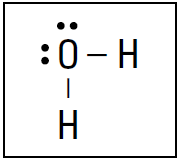


 علم الكيمياء
علم الكيمياء 
 الكيمياء التحليلية
الكيمياء التحليلية 
 الكيمياء الحياتية
الكيمياء الحياتية 
 الكيمياء العضوية
الكيمياء العضوية 
 الكيمياء الفيزيائية
الكيمياء الفيزيائية
 الكيمياء اللاعضوية
الكيمياء اللاعضوية 
 مواضيع اخرى في الكيمياء
مواضيع اخرى في الكيمياء
 الكيمياء الصناعية
الكيمياء الصناعية |
Read More
Date: 5-1-2017
Date: 11-2-2016
Date: 17-1-2018
|
Basic bonds: Writing the electron-dot and Lewis formulas
The following steps explain how to write the electron-dot formula for a simple molecule — water — and provide some general guidelines to follow:
1. Write a skeletal structure showing a reasonable bonding pattern using just the element symbols.
Often, most atoms are bonded to a single atom. This atom is called the central atom. Hydrogen and the halogens are very rarely, if ever, central atoms. Carbon, silicon, nitrogen, phosphorus, oxygen, and sulfur are always good candidates, because they form more than one covalent bond in filling their valence energy level. In the case of water, H2O, oxygen is the central element and the hydrogen atoms are both bonded to it. The bonding pattern looks like this:

It doesn’t matter where you put the hydrogen atoms around the oxygen. I put the two hydrogen atoms at a 90° angle to each other.
2. Take all the valence electrons from all the atoms and throw them into an electron pot.
Each hydrogen atom has one electron, and the oxygen atom has six valence electrons (VIA family), so you have eight electrons in your electron pot. Those are the electrons you use when making your bonds and completing each atom’s octet.

3. Use the N – A = S equation to figure the number of covalent bonds in this molecule.
In this equation,
• N equals the sum of the number of valence electrons needed by each atom. N has only two possible values — 2 or 8. If the atom is hydrogen, it’s 2; if it’s anything else, it’s 8.
• A equals the sum of the number of valence electrons available for each atom. A is the number of valence electrons in your electron pot. (If you’re doing the structure of an ion, you add one electron for every unit of negative charge or subtract one electron for every unit of positive charge.)
• S equals the number of electrons shared in the molecule. And if you divide S by 2, you have the number of covalent bonds in the molecule. So in the case of water,
• N = 8 + 2(2) = 12 (eight valence electrons for the oxygen atom, plus two each for the two hydrogen atoms)
• A = 6 + 2(1) = 8 (six valence electrons for the oxygen atom, plus one for each of the two hydrogen atoms)
• S = 12 – 8 = 4 (four electrons shared in water), and S
÷ 2 = 4 ÷ 2 = 2 bonds
You now know that there are two bonds (two shared pairs of electrons) in water.
4. Distribute the electrons from your electron pot to account for the bonds. You use four electrons from the eight in the pot, which leaves you with four electrons to distribute later. There has to be at least one bond from your central atom to the atoms surrounding it.
5. Distribute the rest of the electrons (normally in pairs) so that each atom achieves its full octet of electrons.
Remember that hydrogen needs only two electrons to fill its valence energy level. In this case, each hydrogen atom has two electrons, but the oxygen atom has only four electrons, so you place the remaining four electrons around the oxygen. This empties your electron pot. Figure 6-5 shows the completed electron-dot formula for water.

Notice that this structural formula shows two types of electrons: bonding electrons, the electrons that are shared between two atoms, and nonbonding electrons, the electrons that aren’t being shared. The last four electrons (two electron pairs) that you put around oxygen aren’t being shared, so they’re nonbonding electrons.
If you want the Lewis formula, all you have to do is substitute a dash for every bonding pair of electrons in the electron-dot formula. Figure 6-6 shows the Lewis formula for water.




|
|
|
|
دراسة يابانية لتقليل مخاطر أمراض المواليد منخفضي الوزن
|
|
|
|
|
|
|
اكتشاف أكبر مرجان في العالم قبالة سواحل جزر سليمان
|
|
|
|
|
|
|
المجمع العلمي ينظّم ندوة حوارية حول مفهوم العولمة الرقمية في بابل
|
|
|